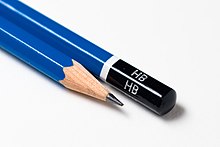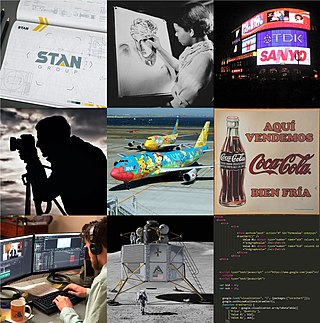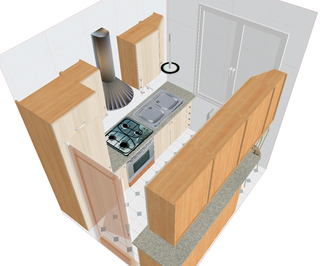
Design tools are objects, media, or computer programs, which can be used to design. They may influence the process of production, expression and perception of design ideas [1] and therefore need to be applied skillfully. [2]

Design tools are objects, media, or computer programs, which can be used to design. They may influence the process of production, expression and perception of design ideas [1] and therefore need to be applied skillfully. [2]
New ideas can come by way of experimenting with tools and methods. Some designers explore ideas using pencil and paper. [3] Others use many different mark-making tools and resources from computers to sculpture as a means of inspiring creativity. Traditionally, objects like pencil, compass, ruler, drawing triangle have been considered design tools and have been used to characterize design and designers. [4] One reason for the success of traditional design tools such as pencil and paper is that these tools can be used without any special knowledge and their usage facilitates a continuous flow of thoughts. [5]
The appropriate development and presentation tools can substantially change how an audience perceives a project. The media used for design can be divided in two categories, visual and verbal. Conventionally, in areas like architecture, industrial design, or graphic design, visual media are considered more important than verbal media. In other areas like engineering, the use of verbal design media may be prevalent.
Visual design tools are, for example, gesture, sketch, drawing, scale model, perspective drawing, photograph, film, video. Eugene S. Ferguson's 1977 paper in Science , entitled "The mind's eye: Nonverbal thought in technology", is credited for clarifying the role of visual reasoning in the thinking process. [6] In this article he reasoned that "Thinking with pictures is an essential strand in the intellectual history of technological development." [7] He concludes his article with the following statement:
In his work claims Ferguson that visual reasoning is a widely used tool used in creating technological artefacts. There is ample evidence that visual methods, particularly drawing, play a central role in creating artefacts.
Verbal design tools are, for example, metaphor, description, discussion, critique, theory, algorithm, calculation, program.
Computer programs have many functions which can be discussed in terms of design tools. One of the most widely used design tools is computer-aided design (CAD) software like Autodesk Inventor, DSS SolidWorks, or Pro Engineer which enables designers to create 3D models, 2D drawings, and schematics of their designs. CAD together with Digital Mockup (DMU) and CAE software such as finite element method analysis or analytic element method allows designers to create models of designs that can be analyzed without having to make expensive and time-consuming physical prototypes.
There is some debate whether computers enhance the creative process of design. [9] Rapid production from the computer allows many designers to explore multiple ideas quickly with more detail than what could be achieved by traditional hand-rendering or paste-up on paper, moving the designer through the creative process more quickly. [10] However, being faced with limitless choices does not help isolate the best design solution and can lead to endless iterations with no clear design outcome. A designer may use sketches to explore multiple or complex ideas quickly [11] without the distractions and complications of software.

Drawing is a visual art that uses an instrument to mark paper or another two-dimensional surface. The instruments used to make a drawing are pencils, crayons, pens with inks, brushes with paints, or combinations of these, and in more modern times, computer styluses with graphics tablets or gamepads in VR drawing software.

A design is the concept of or proposal for an object, process, or system. The word design refers to something that is or has been intentionally created by a thinking agent, and is sometimes used to refer to the inherent nature of something – its design. The verb to design expresses the process of developing a design. In some cases, the direct construction of an object without an explicit prior plan may also be considered to be a design. A design is expected to have a purpose within a certain context, usually having to satisfy certain goals and constraints and to take into account aesthetic, functional, economic, environmental, or socio-political considerations. Traditional examples of designs include architectural and engineering drawings, circuit diagrams, sewing patterns, and less tangible artefacts such as business process models.

Graphic design is a profession, academic discipline and applied art whose activity consists in projecting visual communications intended to transmit specific messages to social groups, with specific objectives. Graphic design is an interdisciplinary branch of design and of the fine arts. Its practice involves creativity, innovation and lateral thinking using manual or digital tools, where it is usual to use text and graphics to communicate visually.

Computer-aided design (CAD) is the use of computers to aid in the creation, modification, analysis, or optimization of a design. This software is used to increase the productivity of the designer, improve the quality of design, improve communications through documentation, and to create a database for manufacturing. Designs made through CAD software help protect products and inventions when used in patent applications. CAD output is often in the form of electronic files for print, machining, or other manufacturing operations. The terms computer-aided drafting (CAD) and computer-aided design and drafting (CADD) are also used.
A modeling language is any artificial language that can be used to express data, information or knowledge or systems in a structure that is defined by a consistent set of rules. The rules are used for interpretation of the meaning of components in the structure of a programming language.
Graphics are visual images or designs on some surface, such as a wall, canvas, screen, paper, or stone, to inform, illustrate, or entertain. In contemporary usage, it includes a pictorial representation of data, as in design and manufacture, in typesetting and the graphic arts, and in educational and recreational software. Images that are generated by a computer are called computer graphics.
Ideation is the creative process of generating, developing, and communicating new ideas, where an idea is understood as a basic unit of thought that can be either visual, concrete, or abstract. Ideation comprises all stages of a thought cycle, from innovation, to development, to actualization. Ideation can be conducted by individuals, organizations, or crowds. As such, it is an essential part of the design process, both in education and practice.

A category of fine art, graphic art covers a broad range of visual artistic expression, typically two-dimensional, i.e. produced on a flat surface. The term usually refers to the arts that rely more on line, color or tone, especially drawing and the various forms of engraving; it is sometimes understood to refer specifically to printmaking processes, such as line engraving, aquatint, drypoint, etching, mezzotint, monotype, lithography, and screen printing. Graphic art mostly includes calligraphy, photography, painting, typography, computer graphics, and bindery. It also encompasses drawn plans and layouts for interior and architectural designs.
Creativity techniques are methods that encourage creative actions, whether in the arts or sciences. They focus on a variety of aspects of creativity, including techniques for idea generation and divergent thinking, methods of re-framing problems, changes in the affective environment and so on. They can be used as part of problem solving, artistic expression, or therapy.
Product design is the process of creating new products for businesses to sell to their customers. It involves the generation and development of ideas through a systematic process that leads to the creation of innovative products. Thus, it is a major aspect of new product development.

A website wireframe, also known as a page schematic or screen blueprint, is a visual guide that represents the skeletal framework of a website. The term wireframe is taken from other fields that use a skeletal framework to represent 3 dimensional shape and volume. Wireframes are created for the purpose of arranging elements to best accomplish a particular purpose. The purpose is usually driven by a business objective and a creative idea. The wireframe depicts the page layout or arrangement of the website's content, including interface elements and navigational systems, and how they work together. The wireframe usually lacks typographic style, color, or graphics, since the main focus lies in functionality, behavior, and priority of content. In other words, it focuses on what a screen does, not what it looks like. Wireframes can be pencil drawings or sketches on a whiteboard, or they can be produced by means of a broad array of free or commercial software applications. Wireframes are generally created by business analysts, user experience designers, developers, visual designers, and by those with expertise in interaction design, information architecture and user research.

Computer-aided architectural design (CAAD) software programs are the repository of accurate and comprehensive records of buildings and are used by architects and architectural companies for architectural design and architectural engineering. As the latter often involve floor plan designs CAAD software greatly simplifies this task.

Graphic art software is a subclass of application software used for graphic design, multimedia development, stylized image development, technical illustration, general image editing, or simply to access graphic files. Art software uses either raster or vector graphic reading and editing methods to create, edit, and view art.
Graphic design careers include creative director, art director, art production manager, brand identity developer, illustrator and layout artist.
Design thinking refers to the set of cognitive, strategic and practical procedures used by designers in the process of designing, and to the body of knowledge that has been developed about how people reason when engaging with design problems.
Eugene Shallcross Ferguson was an American engineer, historian of technology and professor of history at the University of Delaware, particularly known for his 1992 work Engineering and the Mind's Eye.
Visual reasoning is the process of manipulating one's mental image of an object in order to reach a certain conclusion – for example, mentally constructing a piece of machinery to experiment with different mechanisms. In a frequently cited paper in the journal Science and a later book, Eugene S. Ferguson, a mechanical engineer and historian of technology, claims that visual reasoning is a widely used tool used in creating technological artefacts. There is ample evidence that visual methods, particularly drawing, play a central role in creating artefacts. Ferguson's visual reasoning also has parallels in philosopher David Gooding's argument that experimental scientists work with a combination of action, instruments, objects and procedures as well as words. That is, with a significant non-verbal component.
The following outline is provided as an overview of a topical guide to design:

A drafter is an engineering technician who makes detailed technical drawings or CAD designs for machinery, buildings, electronics, infrastructure, sections, etc. Drafters use computer software and manual sketches to convert the designs, plans, and layouts of engineers and architects into a set of technical drawings. Drafters operate as the supporting developers and sketch engineering designs and drawings from preliminary design concepts.

An architectural drawing or architect's drawing is a technical drawing of a building that falls within the definition of architecture. Architectural drawings are used by architects and others for a number of purposes: to develop a design idea into a coherent proposal, to communicate ideas and concepts, to convince clients of the merits of a design, to assist a building contractor to construct it based on design intent, as a record of the design and planned development, or to make a record of a building that already exists.